Counting, adding & subtracting money worksheets for 3rd Grade
-
Are your 3rd Grade students excited about money and the things they will buy with it? Certainly yes! But the question is, can they count money? Maybe no! Hence, as a teacher or parent, you will teach your children how to count money and become money masters. You can do this using our counting, adding & subtracting money worksheets for 3rd Grade.
These worksheets are taken from Mathskills4kids.com, the best website for mastering tips and the most appropriate way of counting, adding, and subtracting money with confidence and ease.
This article will also share some awesome strategies for identifying and comparing different coins and bills. We now encourage you to get your 3rd graders with these money worksheets and develop their money skills while having fun at the same time.
Let's dive in!
Why learning about money is important for 3rd Graders
As a 3rd grader, learning about money is important for many reasons. First, we can agree that money is everywhere and frequently used daily. We use it to buy things, save for the future, donate to causes we care about, and more.
Learning about money is a practical skill and a valuable life lesson. Hence, by using these Mathskills4kids free counting, adding & subtracting money worksheets to teach your 3rd grader about money, you are helping them to:
- Understand the value of different coins and bills
- Develop their math skills such as addition, subtraction, place value, regrouping, and borrowing
- Improve their problem-solving and critical-thinking skills
- Learn how to make smart financial decisions
- Gain confidence and independence
-
BROWSE THE WEBSITE
-
DOWNLOAD FREE WORKSHEETS
-
-
3rd GRADE MATH TOPICS
- Number and compapring
- Place value
- Addition
- Subtraction
- Understand multiplication
- Multiplication skill builders
- Multiplication fluency
- Multiplication
- Understand division
- Division skill builders
- Division fluency
- Division practice
- Mixed operation
- Properties
- Equations & variations
- Estimate & rounding
- Logical reasoning
- Patterns
- Money
- Telling time
- Data graph & probability
- Understanding fractions
- Equivalent fractions
- Comparing and ordering fractions
- Operations with fractions
- Unit of measurement
- Two-dimensional shapes
- Triangles and quadrilaterals
- 3D shapes
- Geometric measurement
-
-
Count coins and bills up to $5 bill
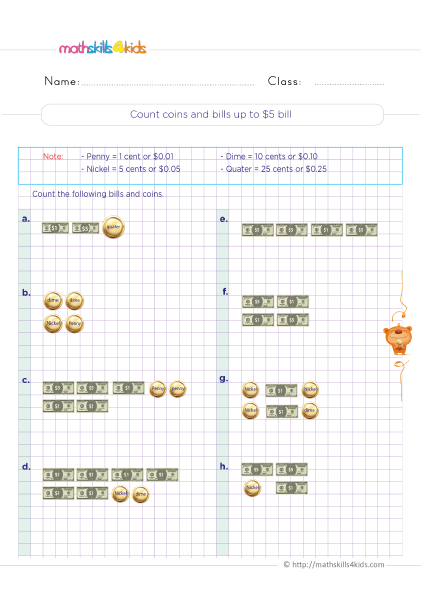 Print it...
Print it...
-
Counting coins and bills up to $5 bill word problems
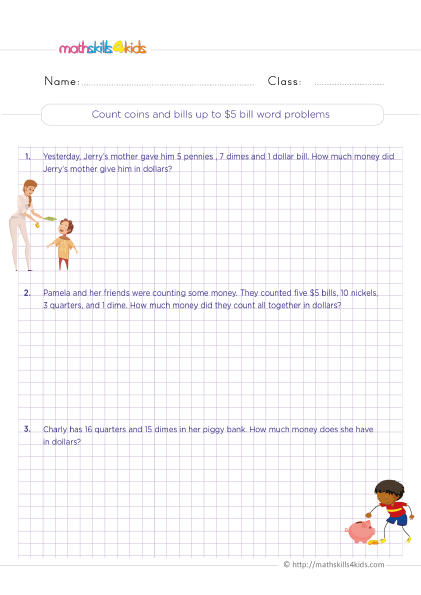 Print it...
Print it...
-
Do you have enough money to make purchases - up to $10
 Print it...
Print it...
-
How do you solve inequalities with money amounts?
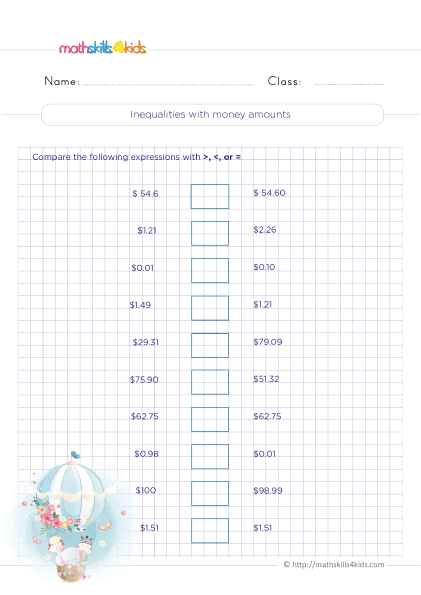 Print it...
Print it...
-
How to put money amounts in order?
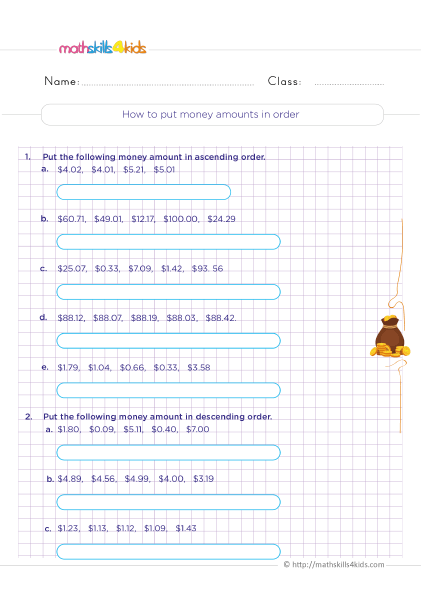 Print it...
Print it...
-
Adding and subtracting money word problems
 Print it...
Print it...
-
Count coins and bills up to $5 bill
-
Buying is supporting us!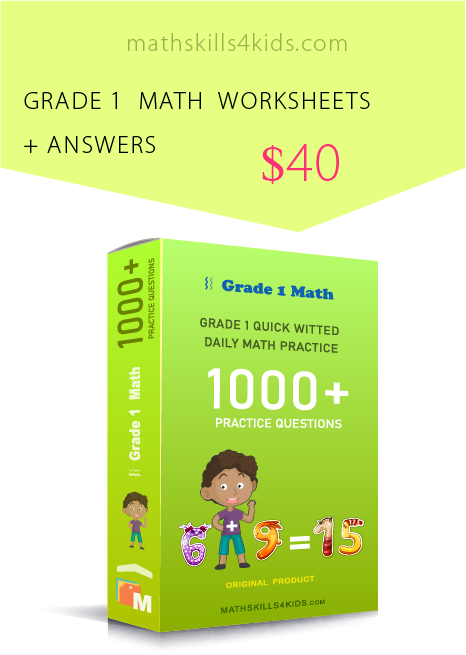
Buy Now...
-
-
Counting Money: How to identify and compare different coins and bills
One of the first steps to becoming a money master is learning how to count money. Counting money involves identifying and comparing different coins and bills, such as pennies, nickels, dimes, quarters, half-dollars, dollars, fives, tens, twenties, etc.
To effectively count money, your 3rd grader needs to know the following:
- The name and value of each coin and bill
- How to group coins and bills by their value
- How to write money amounts using the dollar sign ($) and the decimal point (.)
- How to compare money amounts using symbols such as <, >, =
These worksheets will give your child various combinations and amounts of coins and bills, increasing in difficulty. They will also challenge your child to solve word problems involving counting money.
-
Adding money: How to use place value and regrouping to add money amounts
Another essential skill for your 3rd grader to learn is adding money. Adding money involves adding the values of different coins and bills to find the total amount. To add money, your 3rd grader needs to know the following:
- How to align the decimal points when adding two or more money amounts
- How to use place value to add each column of digits from right to left
- How to regroup or carry over when the sum of a column is more than 10
These worksheets will give your child various examples of adding money amounts with and without regrouping. They will also challenge your child to solve word problems involving adding money.
-
Subtracting money: How to use borrowing and subtracting across zeros to subtract money amounts
The next skill for your 3rd grader to learn is subtracting money. Subtracting money involves finding the difference between two money amounts. To subtract money, your 3rd grader needs to know the following:
- How to align the decimal points when subtracting two money amounts
- How to use place value to subtract each column of digits from right to left
- How to borrow or regroup when the minuend (the number being subtracted from) is smaller than the subtrahend (the number being subtracted)
- How to subtract across zeros when there are one or more zeros in the minuend
These worksheets will give your child various examples of subtracting money amounts with and without borrowing. They will also challenge your child to solve word problems involving subtracting money.
-
MathSkills4Kids practice worksheets: Fun and engaging counting, adding & subtracting money exercises to reinforce money skills
Now that you have learned the basics of counting, adding, and subtracting money, it's time to put your skills to the test with some fun and engaging practice worksheets from MathSkills4Kids. These worksheets help you review and apply what you have learned in various contexts and scenarios involving money. You will find exercises that challenge you to:
- Count coins and bills up to $5 bill word problems. For example, how many quarters are in $1.25? How many dimes and nickels are in $0.45? How much money do you have if you have two $1 bills, three quarters, and four pennies?
- Purchases up to $10: do you have enough money? For example, if you want to buy a book that costs $6.75 and a pencil that costs $0.50, do you have enough money if you have a $10 bill? How much change will you get back?
- Correct amount of change. For example, yesterday, Elvis paid $2.40 to buy a jar of beans costing $1.09. He received one $1 bill and 31 cents as change. Did he receive the correct amount as change? If not, how much more or less did he receive?
- Making change. For example, Rita bought a pair of shoes for $19.35. She handed the cashier a twenty–dollar bill. What coins or bills did she most likely receive as change? How would you make change for $20 using the least number of coins and bills possible?
- Inequalities with money amounts. For example, which is more: $3.50 or $3.05? Which is less: $4.25 or $4.75? How do you write an inequality symbol (<, >, =) between two money amounts?
- How to put money amounts in order. For example, how do you arrange these amounts from least to greatest: $2.15, $1.75, $2.05, $1.95? How do you arrange them from greatest to least?
- Adding and subtracting money. For example, how do you add $2.35 and $1.65? How do you subtract $3.50 from $5? How do you regroup or borrow when adding or subtracting money amounts that have different numbers of digits?
- Add money word problems. For example, how much money do you have in total if you earn $10 for mowing the lawn and $5 for washing the dishes? How much money do you spend if you buy a sandwich for $3.25 and juice for $1.50?
As earlier said, you can find these counting, adding & subtracting money worksheets for 3rd graders and more on the MathSkills4Kids website, where you can print them out or complete them online. You can also check your answers with the answer keys provided.
-
How to review and apply what you learned from the worksheets
After completing the worksheets, reviewing what you learned and applying it to real-life situations involving money is important. Here are some tips on how to do that:
- Review your answers and check for any mistakes or errors. If you find any, try correcting them and understanding where you went wrong.
- Review the concepts and skills that you learned from the worksheets. For example, review how to identify and compare different coins and bills, use place value and regrouping to add or subtract money amounts, use borrowing and subtracting across zeros to subtract money amounts, etc.
- Apply what you learned to real-life situations involving money. For example, practice counting the money in your piggy bank or wallet, practice making purchases and getting change at a store or online, practice budgeting your allowance or savings for something you want to buy, etc.
- Challenge yourself with more advanced problems or questions involving money. For example, try to solve problems involving decimals or fractions of a dollar, convert between different currencies or units of measurement, estimate or round money amounts, etc.
Bonus: Find more resources to reinforce money learning skills in second grade here!
If you're looking for more ways to help your child to reinforce their money math skill, you're in luck! We've compiled a list of some of the best resources offering counting, adding & subtracting money worksheets for 3rd Grade math practice.
These resources include:
- k5learning: This website include fun money worksheets from recognizing coins to counting coins and shopping problems. https://www.k5learning.com/free-math-worksheets/third-grade-3/counting-money.
- Math Salamanders: On this website, you will find a wide range of free printable Money Challenges, which will help your child learn to solve problems and develop their thinking skills while applying their money skills at the same time. https://www.math-salamanders.com/money-worksheets-3rd-grade.html.
- com: This website has a lot of money worksheets, printables, fun games, and educational materials to help students better understand change, financial denominations, addition, and subtraction money. https://www.education.com/worksheets/third-grade/money-math/.
-
Thank you for sharing the links of MathSkills4Kids.com with your loved ones. Your choice is greatly appreciated.
Conclusion: Keep Practicing and Have Fun
Learning about money is an important skill for 3rd graders because it helps them understand the value of things, develop their math skills and prepare them for the real world.
By using the MathSkills4Kids practice worksheets, you can reinforce your money skills in a fun and engaging way. You can also review and apply what you learned to real-life situations involving money.
Always check your work and challenge yourself with more advanced problems or money-related questions.
Thank you for reading, and happy learning!
